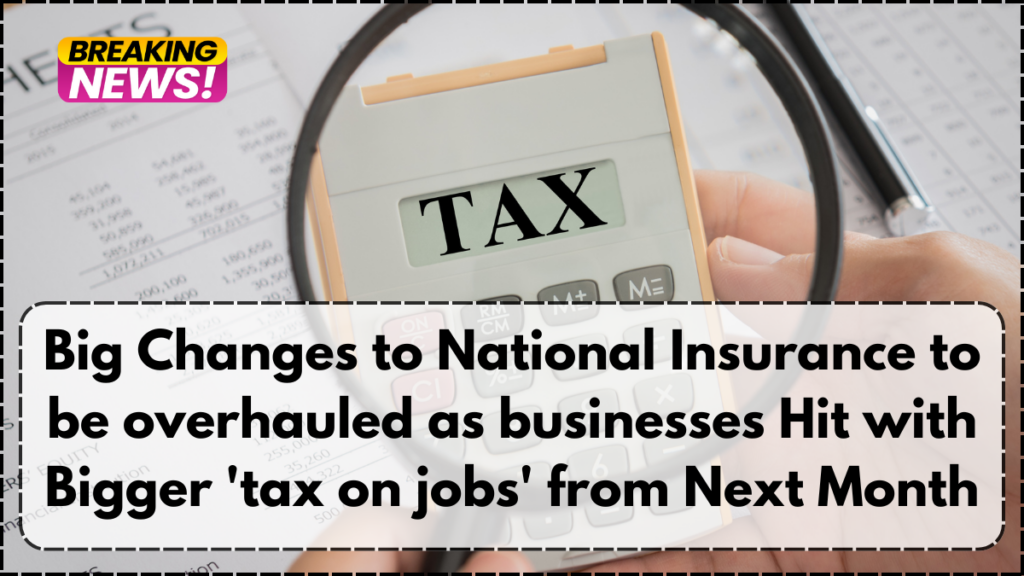Starting April 6, 2025, UK businesses will face new National Insurance (NI) rules that increase operating costs and reshape employer obligations. These changes, stemming from Chancellor Rachel Reeves’s Autumn Statement in 2024, are being criticized for placing extra pressure on the private sector amid weak economic growth.
Industry experts are raising concerns over how these policy shifts could accelerate closures across the high street and stall job creation. According to recent analysis, as many as 17,000 retail outlets may be at risk of shutting down due to the financial burden.
Despite criticism, Reeves defends her strategy, asserting it’s necessary to boost GDP and reduce the nation’s deficit. However, updated projections from the Office for Budget Responsibility (OBR) show a gloomy outlook, halving expected GDP growth in 2025 from 2% to just 1%.
Let’s break down the confirmed changes and what they mean for businesses.

Key National Insurance Adjustments Effective April 2025
| Change Type | Description |
|---|---|
| Employer NI Rate | Increased from 13.8% to 15% |
| Secondary Threshold (Class 1 NI) | Reduced from £9,100 to £5,000 |
| Employment Allowance | Raised from £5,000 to £10,500 |
Employer National Insurance Rate to Increase
One of the most impactful changes is the increase in the employer National Insurance contribution rate. From April 6, 2025, the rate will jump from 13.8% to 15%, marking the sharpest increase in over a decade.
Dubbed a “tax on jobs” by critics, this measure will make it more expensive for companies to retain or hire staff. Although the change doesn’t directly affect employees, businesses might reduce hiring, scale back on wage increases, or shift costs to consumers.
According to NerdWallet analysts, this cost pressure could make some employers hesitant to expand their workforce. When combined with increased minimum wages, the financial strain could be too much for some small and mid-sized firms.
Reduction in NI Contribution Threshold for Employers
In addition to higher rates, the threshold at which employers begin paying Class 1 NI contributions is being slashed. Starting April 2025, the secondary threshold will fall from £9,100 to £5,000.
This change means businesses will be taxed on a greater portion of their employees’ earnings. It aligns with the broader fiscal strategy of freezing personal tax thresholds, contributing to what’s known as “fiscal drag.” Essentially, workers and businesses end up paying more even if income levels remain unchanged.
A recent breakdown by Interactive Investor shows that a worker earning £20,000 will still pay more tax in the 2024-25 fiscal year, despite a cut in employee NI from 12% to 8%, due to this shift in thresholds.
Employment Allowance Doubled to Support Small Businesses
In an attempt to offer some relief, the Employment Allowance available to eligible businesses will increase from £5,000 to £10,500 in April 2025.
This measure allows smaller businesses to reduce their total NI bill, which could soften the blow of higher rates. The increase is aimed primarily at helping firms with limited cash flow and lower payrolls.
Kevin Mountford, co-founder of Raisin UK, noted that while the increase is welcome, it doesn’t offset the broader economic implications. The government is using these tax changes to tackle an estimated £22 billion deficit, but the result could be weakened business investment and restricted wage growth.
Long-Term Implications for the UK Economy
Although the Treasury hopes these changes will stabilize public finances, the short-term impact on growth and employment may be significant. With GDP growth projections down to just 1% for 2025, some fear the UK economy could enter a stagnation period.
Businesses are encouraged to revisit their hiring strategies, payroll management, and tax planning to adapt to the upcoming changes.
Conclusion
The National Insurance updates coming in April 2025 mark a pivotal shift in employer responsibilities. With higher contribution rates and lower thresholds, businesses need to prepare for increased payroll costs. While the Employment Allowance hike offers some relief, many firms—especially in retail and other high-employment sectors—will feel the pressure.
Strategic financial planning and a close review of staffing budgets will be essential to weather the impact.
FAQs About the 2025 National Insurance Changes
What is the new employer National Insurance rate in 2025?
Starting April 6, 2025, employers must pay 15% in National Insurance contributions, up from the previous 13.8%.
How does the secondary threshold change affect businesses?
The threshold is dropping from £9,100 to £5,000, meaning employers will pay NI on a larger portion of employee earnings, increasing their tax liability.
Who benefits from the Employment Allowance increase?
Small businesses with eligible payrolls can now claim up to £10,500 to offset their employer NI bill. This aims to help mitigate the impact of the rate hike.
When do these National Insurance changes take effect?
All listed changes come into force on April 6, 2025.
Will employees be directly affected by these employer-focused changes?
Not directly, but there may be indirect effects such as slowed wage growth, fewer job openings, or price increases as businesses adjust to higher costs.
For More Information Click Here
Pari is a passionate writer known for captivating stories that blend imagination and reality. Inspired by travel, history, and everyday moments, Pari crafts narratives that resonate deeply with readers.




